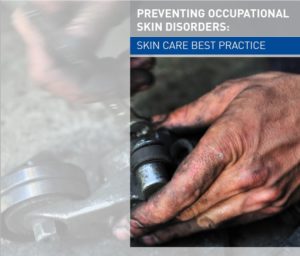Occupational Skin Disorders
Occupational Skin Disorders: 3-Moments of Skin Care

Dermatitis is just one of a number of Occupational Skin Disorders (OSDs) which collectively pose a threat to health, safety and efficiency in the workplace, as well as to the mental, physical and social wellbeing of the individuals affected.
According to the American Journal of Industrial Medicine more than one in 10 workers suffer from dermatitis, sore and inflamed skin on the hands which can make routine manual tasks a challenge.
The 3-Moments of Skin Care is a universal best practice standard for skin care which heralds a breakthrough in the fight against OSDs.
 Occupational hand hygiene and skin care specialists, Deb, recently launched whitepaper, ‘Preventing Occupational Skin Disorders: Skin Care Best Practice’, downloadable from SHP here.
Occupational hand hygiene and skin care specialists, Deb, recently launched whitepaper, ‘Preventing Occupational Skin Disorders: Skin Care Best Practice’, downloadable from SHP here.
Within the white paper, the 3-Moments of Skin Care is clearly reaffirmed as the industry standard for skin care and the document explains how businesses can adopt these moments to improve skin behaviour compliance in the workplace.
The 3-Moments of Skin Care is the work of an expert panel of eight international dermatologists who have combined their wealth of experience and a comprehensive analysis of 75 published occupational skin care studies.
The studies identify when skin care action is required and highlights when skin protection or restorative creams should be applied by workers.
Paul Jakeway, Marketing Director at Deb, says: “The aim of the 3-Moments of Skin Care is to help occupational health and safety professionals develop a culture where skin health is considered a priority and where the wider workforce can understand, address and improve skin care behaviour compliance.
“The ultimate objective is to reduce the incidence of OSDs and change workplace culture so that it is no longer deemed acceptable for workers to have to tolerate painful skin conditions. We believe the 3-Moments of Skin Care will form the catalyst for change in skin care behaviour.”
To find out more, download the ‘Preventing Occupational Skin Disorders: Skin Care Best Practice’ whitepaper here.
What makes us susceptible to burnout?
In this episode of the Safety & Health Podcast, ‘Burnout, stress and being human’, Heather Beach is joined by Stacy Thomson to discuss burnout, perfectionism and how to deal with burnout as an individual, as management and as an organisation.
We provide an insight on how to tackle burnout and why mental health is such a taboo subject, particularly in the workplace.
Occupational Skin Disorders: 3-Moments of Skin Care
According to the American Journal of Industrial Medicine more than one in 10 workers suffer from dermatitis, sore and inflamed skin on the hands which can make routine manual tasks a challenge.
Safety & Health Practitioner
SHP - Health and Safety News, Legislation, PPE, CPD and Resources Related Topics
‘It’s time to tackle skin problems in the construction industry’
A third of outdoor workers don’t apply sun cream, new research has found
Prepare don’t repair: Get your skin care in order this winter

 Occupational hand hygiene and skin care specialists, Deb, recently launched whitepaper,
Occupational hand hygiene and skin care specialists, Deb, recently launched whitepaper, 